Previous Page | Right click this page to print.
Body Condition
The next thing we have to look at is the body condition. The body condition is an estimation of the body fat content, by estimating the subcutaneous fat in the horse. The body condition scoring system goes from one to nine. One being very thin, emaciated and nine being obese. Ideal for the athletic horse or the performance horse is a body condition score of about five. And I will show a couple of pictures here in a minute that talks about, or that illustrates, what each one of these body condition scores is. When you have a horse on a fat supplemented diet, you can go ahead and keep them a little bit thinner because they are going to get a little bit of additional energy from the fat that is in the diet, so they have to carry a little bit less fat on their body.
This is how we estimate the horse’s body fat content, subcutaneously.
What we do is we palpate in these six different areas on the horse and
get a pretty good idea of how much fat is under the skin. And then we
assign a score to each individual body part.

It does not do you any good, if you just look at a horse and check two or three spots and then assign it a score. You have to each body part individually and if you take the equine nutrition class that I teach, we dedicate one lab where we just do that. We palpate each body part individually, assign it a score and then add it all up and divide it by six and that will be the over all score of that horse’s body condition. The reason this is really important is because if you look at horse that is not in very good shape, especially a horse that may be older, what would you expect more of the fat to be deposited? If you think of brood mares especially, where would you think more of the fat will be deposited? It will be further down, mainly due to gravity. There will be more fat deposited along the ribs and behind the shoulders, there will be less fat over the back and around the tail head. If you look at three spots and they all happen to be over the back, those three spots on the back, and you may come to the conclusion that your brood mare has a body condition of a four or five, when in essence she is more a seven or an eight because there is a lot of fat over the ribs and there maybe a lot of fat behind the shoulder. Therefore, you got to do each individual part and then add it all up and divide it. In a performance horse, the fat is going to be distributed fairly equally throughout the body, so you do not have to worry as much about it in a performance horse, but in any other horse you do.
Here is a body condition score of one.
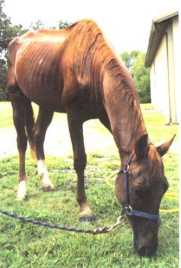
If you look at this horse, in addition to having lost a lot of body fat or almost all body fat, what else is that horse beginning to metabolize? It is definitely metabolizing a lot of muscle because he has to use the muscle for basic metabolic upkeep. And then pretty soon once the muscle is used up, he is going to go down hill really fast.
What about here?
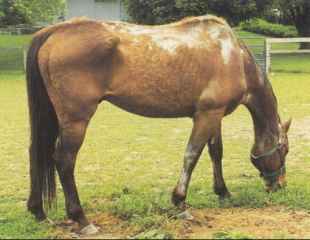
This particular horse if a body condition score of three. And the main thing that you will see right away is a protruding back bone and that tells you, if that back bone is sticking out or visible from the wither all the way to the tail head, that he is definitely under a four, that he will be a body condition score of three. He has not metabolized a lot of muscle yet because there is still a little bit of fat on him, not much. And really, you could make the argument that this horse is close to a body condition score of two. But he is on the upper range of two or lower range of three.
Here is a body condition score of four.
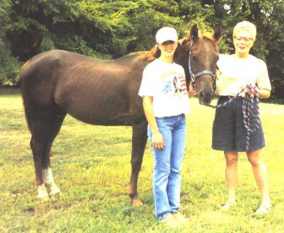
You can see the backbone a little bit and some of that is confirmation. When you body condition score a horse, you should not use confirmation in anyway, other than making an effort not to judge it. Confirmation has nothing to do with how much fat is on the horse’s body. But it does have something to do with how much bone may be sticking out of the horse. So you got to keep that in mind. The basic difference between body condition score of four and five is that on a four you will be able to see the ribs, on a five you will not. So that is a cut-off that you can tell without really palpating a horse. So if you can see the ribs on the horse, he is not a five. If you cannot see the ribs on the horse, he is at least a five.
Here is a body condition score of five.
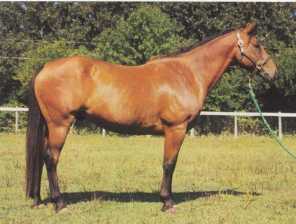
You cannot see the ribs. And also it is important that you do not judge that when a horse has a lot of winter hair because you may not be able to see the ribs on a body condition score of three with a lot of winter hair. It is important that he has a good hair coat, short hair, when you make that determination.
Here is a body condition score of six.
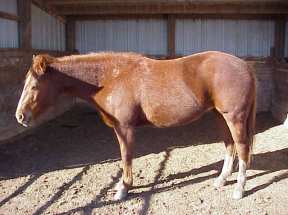
You will have about a half inch to three quarters of an inch of fat over
the ribs. You cannot see the back bone anymore at this point.
Previous Page | Right click this page to print.